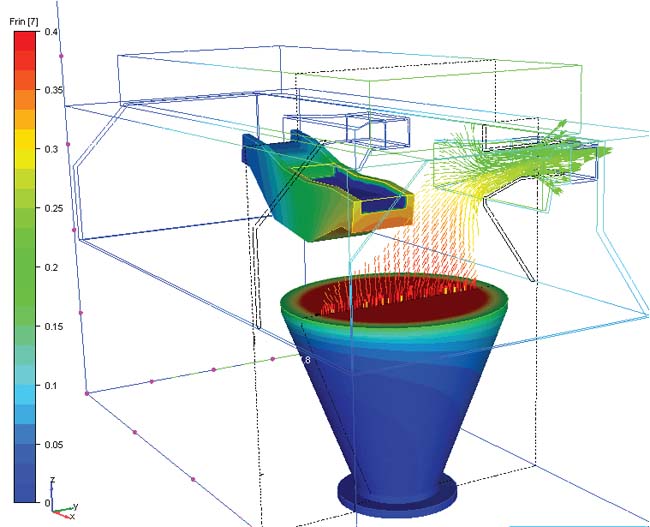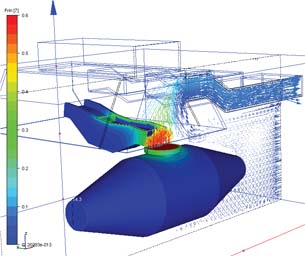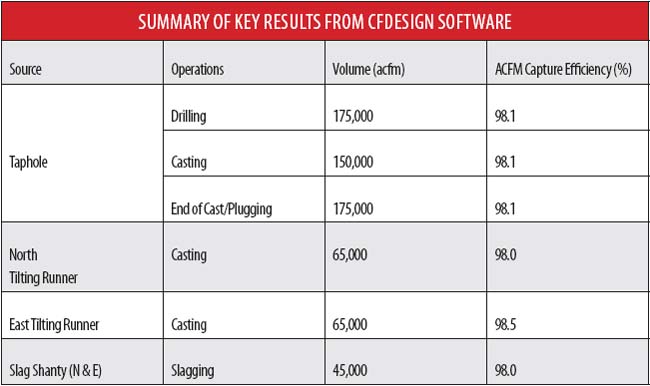Latest News
February 1, 2010
By James Earl, Brian Bakowski, and E. Joseph Duckett
When Severstal North America—one of the largest steel manufacturers in the U.S.—needed to rebuild one of its blast furnaces, it faced the challenge of designing the emission control system for a new casthouse. The project would have been difficult—maybe nearly impossible—without upfront computational fluid dynamics (CFD) software.
 A simulation generated by CFdesign software shows a plume of particulates coming off the ladle of molten steel. Red arrows indicate a high-level of particulates being drawn into an exhaust duct. |
Under U.S. Environmental Protection Agency (EPA) regulations, casthouse particulate emissions must be controlled with what is called Maximum Achievable Control Technology (MACT). MACT compliance is measured by stack emission concentrations and the opacity of emissions that escape from the casthouse building. The Michigan Department of Environmental Quality (MDEQ) also has established an opacity limit. In our case, the casthouse, which would include a new set of hoods, ductwork, fabric filtration equipment, and fans, had to meet both U.S. and Michigan environmental regulations by capturing 98 percent of particulates.
MACT compliance is usually based on actual observations of casthouse operations to determine emission intensities, crosswind speeds, and vertical rise rates. But Severstal could not do that because the rebuilt casthouse was very different in configuration and operation from previous designs.
Our solution was to use CFdesign software from Blue Ridge Numerics to conduct a comprehensive design study that simulated the new equipment under every conceivable operating condition.
Setting up the Model
The first step in our project was to set up the CAD geometry in CFdesign to include the physical boundaries and internal blockages to fluid flow within the casthouse. The geometry of the model, in this case created in MicroStation software from Bentley Systems, included the physical bounds of the casthouse as well as the furnace, tuyere platform (the outlet through which air is blown into the furnace), iron and slag runners, hoods, and other equipment.
 CFdesign accurately predicted performance of a Severstal casthouse emission control system in early design stages. This simulation shows particulates flowing off an iron tilting runner into an awaiting bottle car. Red indicates a high level of particulates and dark blue indicates air without particulates. |
After setting up the geometry in Micro-Station, the model was meshed in CFdesign, which provides built-in tools for simulating the conditions that the new equipment and structure would face. For the casthouse model, we needed to simulate the temperature and velocity of incoming air; temperature, velocity, fume, and combustion components associated with the casting and pouring of hot metal; and air-flow rates for the tilting runner duct, taphole hoods, and slag pot shanty duct.
Information describing these processes must be incorporated into the model as boundary conditions to accurately evaluate the operation of the fume hoods that control emissions. Input was derived from previous experience at similar casthouse operations, where heat and material balance calculations were coupled with video analyses.
Establishing the Parameters
After the model geometry and simulation information were entered, the initial hood designs were incorporated into the model to evaluate their performance.
Once again, heat and material balance calculations and video of similar casthouses were analyzed to establish fume rise velocities, intensities, and horizontal movement, especially at the taphole, from which the most concentrated emissions flow. From these previous studies, the following parameters were established:
• metal temperature: 2800 degrees F
• slag temperature: 2700 degrees F
• rise rate: 900fpm at the taphole
• cross drafts: 450fpm at the taphole (5 mph) and 900fpm under tilters.
Other values that were assigned were based on previous studies.
 |
Simulating Real-world Conditions
After establishing the fundamental geometry and base set of conditions, finding the optimal design was an iterative four-step process. First, using initial hood designs and ventilation rates, we determined capture efficiencies for tapholes, iron tilters, and slag pot areas. Second, if initial hood/ventilation combinations did not achieve the 98 percent emission control rate, we would revise the geometry. Third would be to re-run the model with the revised design. And four would be to repeat steps 2 and 3 until acceptable emission control is achieved, then apply the acceptable model parameters to the emission control system design.
Each time a simulation was run, CFdesign performed a series of complex calculations and then compared them to determine the degree to which they agreed. The software then automatically adjusted the model and reran the simulation to achieve close convergence for small sub-sections in terms of temperature, velocities, and other parameters. It required 225 to 250 iterations of each model to achieve convergence and calculate a valid capture efficiency.
Capture efficiency was computed as the probability that a fume particle generated at each source (taphole, tilter, or slag shanty) would be captured by each hood and drawn through the ductwork to the bag house. The next—and most important—step in the calculation was to determine fume capture percentages for each individual operation.
The entire study entailed dozens of CFD simulations to arrive at an optimal mix of hood configurations and ventilation volumes. A summary of the key results from CFdesign is shown in the table. In addition to numerical results, CFdesign provided static and dynamic images that created a better understanding of what was occurring during the simulations (see images).
Accurate and Cost-effective
Upfront CFD using CFdesign software proved to be indispensable in optimizing design of the emission control system. It enabled us to successfully establish ventilation volumes, hood configurations, and volume distribution profiles for 50 operating scenarios for the new blast furnace in three months, without costly physical testing.
The new furnace is fully operational and in compliance with the MACT regulations. Upfront CFD proved to be an accurate and cost-effective method to predict actual performance under real-world conditions.
More Info:
Bentley Systems
James Earl works for Severstal North America. Brian Bakowski and E. Joseph Duckett work for SNC-Lavalin America. Send comments about this article to [email protected].
Subscribe to our FREE magazine, FREE email newsletters or both!
Latest News
About the Author
DE’s editors contribute news and new product announcements to Digital Engineering.
Press releases may be sent to them via [email protected].






